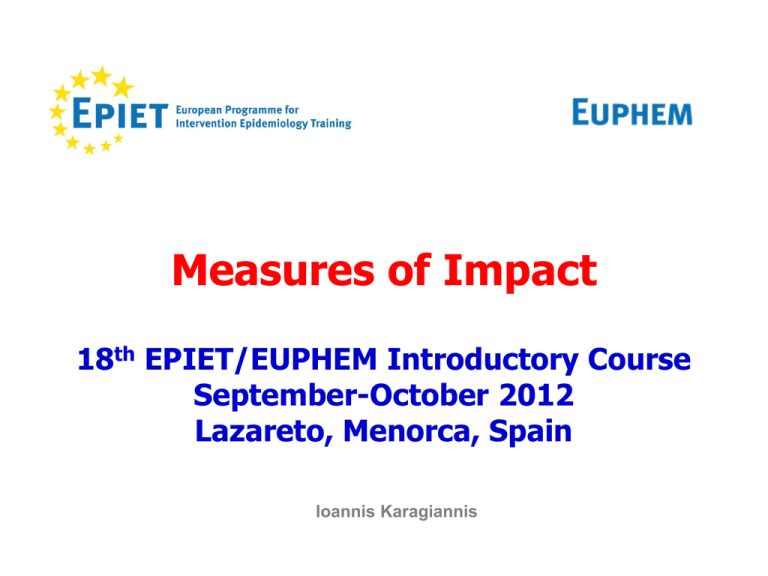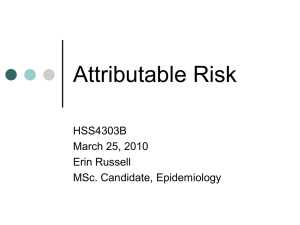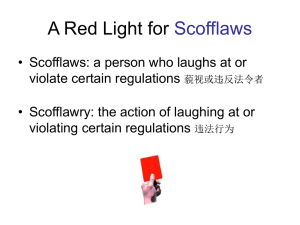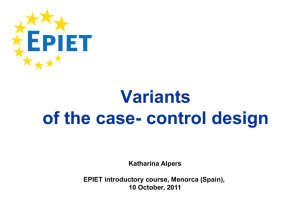Measures of Impact
advertisement

Measures of Impact 18th EPIET/EUPHEM Introductory Course September-October 2012 Lazareto, Menorca, Spain Ioannis Karagiannis Objectives • To define measures of impact • To calculate the attributable risk - among the exposed - in the population • Eventually, make sense of stuff 2 Scenario • You are in charge of health promotion “Preventing automobile-related deaths” • Limited budget best reduction of deaths • Evidence: retrospective cohort study: “causes of automobile-related deaths” 3 Relative Risks Relative Risk Driving too fast 5 Driving while drunk 11 • Best reduction of deaths? • Prevent drink & drive? • Prevent speeding? 4 Relative Risks Risk (exposed) Risk (unexposed) 0.000005 0.000001 0.5 0.1 RR = 5.0 5 Measures of Impact • Provide information about the public health impact of an exposure • Contribution of an exposure to the frequency of disease • Several concepts - Attributable risk (AR) Attributable risk among exposed (AR%) Attributable risk in the population (PAR) Preventable fraction among exposed (PF) 6 Attributable Risk (AR) (synonyms: Risk Difference) • Quantifies disease burden in exposed group attributable to exposure in absolute terms • AR = Re - Ru • Answers: - what is the risk attributed to the exposure? - what is the excess risk due to the exposure? • Only use if causality “exposure outcome” 7 Attributable Risk (AR) • AR = Re - Ru Outcome no yes exposed a b a a+b = Re a+b not exposed c d c c+d = Ru c+d Attributable Risk = a a+b - c c+d Attributable Risk = Re – background risk 8 Attributable Risk (AR) Risk How high is the added risk of dying caused by the exposure “speeding“? 0.05 Risk of death by speeding Added risk ? Risk of death by driving below the speed limit 0.01 0.00 exposure: speeding 9 AR Speeding Outcome Speeding Dead Alive Yes No 100 1900 Risk 2000 80 7920 8000 180 9820 10000 Risk Ratio Risk Difference 5 0.04 0.05 0.01 AR (speeding) = 0.05 - 0.01 = 0.04 “speeding increases the risk of dying by 0.04. Four out of 100 speeding drivers will die in addition to normal (=background) because they drove too fast“. 10 AR Drunk driving Outcome Drunk Driving Dead Alive Yes No 45 255 Risk 300 135 9565 9700 180 9820 10000 Risk Ratio Risk Difference 11 0.14 0.15 0.01 AR (drunk driving) = 0.15 - 0.01 = 0.14 “drunk driving increases the risk of dying by 0.14. Fourteen out of 100 drunk drivers die in addition to normal (background) death by driving because they were drunk while driving." 11 Summary so far Measure Relative Risk Attributable Risk Speeding Drunk driving 5 0.04 11 0.14 12 Attributable Risk Percent (AR%) (synonyms: Attributable Fraction) • Attributable risk expressed as a percentage of risk in the exposed population • Proportion of disease among the exposed which: - can be attributed to the exposure - could be prevented by eliminating the exposure • AR% looks at exposed population, not the total population 13 Attributable Risk Percent (AR%) • Example speeding: What proportion of all speeding deaths (denominator) died because they drove too fast (numerator)? AR% = deaths caused by speeding deaths of all who drove too fast x 100 14 Attributable Risk Percent (AR%) RR > 1 Risk (exposed) - Risk (unexposed) AR% = = = Risk (exposed) Risk (exposed) Risk (exposed) - 1 - Risk (unexposed) Risk (exposed) 1 x 100 x 100 x 100 Relative Risk = RR - 1 x 100 RR 15 AR% Speeding drivers Outcome Speeding Dead Alive Yes 100 1900 Risk 2000 AR% 0.05 0.05-0.01 = 80% 0.05 No 80 7920 8000 180 9820 10000 0.01 AR% (speeding) = 80% “80% of all people who died while driving too fast, died because they drove too fast“. 16 AR% Drunk drivers Outcome Drunk Driving Dead Alive Yes 45 255 Risk 300 AR% 0.15 0.15-0.01 = 93% 0.15 No 135 9565 9700 180 9820 10000 0.01 AR% (drunk driving) = 93% “93% of all people who died while being drunk, died because they were drunk“. 17 Summary so far Measure Relative Risk Attributable Risk Attributable Risk% Speeding Drunk driving 5 0.04 80% 11 0.14 93% 18 AR & AR% in Case-Control Studies AR% = Relative Risk - 1 x 100 Relative Risk • No direct risk estimates in case-control study - AR (risk difference) and AR% calculation IMPOSSIBLE! 19 AR & AR% in Case-Control Studies AR% = Relative Risk - 1 x 100 Relative Risk • No direct risk estimates in case-control study - AR (risk difference) and AR% calculation IMPOSSIBLE? • If odds ratio approximates relative risk, then AR% = Odds Ratio - 1 x 100 Odds Ratio 20 Population Attributable Risk (PAR%) • Proportion of cases in the total population attributable to the exposure • Proportion of disease in the total population that could be prevented if we could eliminate the risk factor • Determines exposures relevant to public health in community • Only use if causality “exposure outcome” 21 Population Attributable Risk (PAR%) • Example speeding: What proportion of all people who died (denominator) died because they drove too fast (numerator)? PAR% = deaths caused by speeding total deaths in the population x 100 22 Population Attributable Risk (PAR%) Risk (total pop) - Risk (unexposed) PAR% = Risk (total pop) x 100 p (RR - 1) PAR% = x 100 p (RR - 1) +1 p = proportion of population exposed PAR% = p(cases) x AR% p(cases) = proportion of cases exposed 23 PAR(%) according to the relative risk for various level of exposure frequency among cases 100.0% Pe 10% Pe 25% Pe 50% Pe 75% Pe 100% (AFe) Population attributable fraction 90.0% 80.0% 70.0% 60.0% 50.0% 40.0% 30.0% 20.0% 10.0% 0.0% 1 2 3 4 5 6 Relative risks 7 8 9 10 PAR% Speeding Outcome Speeding Dead Alive Risk Yes 100 1900 2000 0.050 No 80 7920 8000 0.010 risk in unexposed 180 9820 10000 0.018 risk in total population Risk (total) - Risk (not exposed) 0.018 - 0.01 = PAR% = = 0.44 Risk(total) 0.018 = 44% 25 PAR% Speeding dead alive Risk speeding 100 1900 2000 100/2000 = 0.05 not speeding 80 7920 8000 80/8000 = 0.01 180 9820 10000 Attributable Risk (AR) = 0.05 - 0.01 = 0.04 AR% = AR Risk(exposed) x 100 = (0.04/0.05) x 100 = 80% p(cases) = % cases exposed = 100/180 = 0.55 PAR% = pc x AR% = 0.55 x 80% = 44% 26 PAR% Drunk driving Outcome Drunk Driving Dead Alive PAR% = Risk Yes 45 255 300 0.150 No 135 9565 9700 0.014 risk in unexposed 180 9820 10000 0.018 risk in total population Risk (total) - Risk (unexposed) Risk(total) 0.018 - 0.014 = = 0.22 0.018 = 22% 27 Summary Measure Speeding Drunk driving Relative Risk Attributable Risk Attributable Risk% Pop. attributable risk% % drivers with risk factor in population 5 0.04 80% 44% 20% 11 0.14 93% 22% 3% • Best reduction of deaths? • Prevent drinking or speeding? 28 PAR% in Case-Control Studies • proportion of controls exposed ≈ proportion of population exposed PAR% = Pcontrols – (OR – 1) Pcontrols (OR – 1) + 1 x 100 Pcontrols = Proportion of controls exposed PAR% = Pcases ( OR – 1 OR ) x 100 Where Pcases = proportion cases exposed 29 Summary Measure Meaning Question answered RR, OR Strength of association (between exposure and outcome) Is the exposure associated with the risk of getting ill/ the outcome? AR Excess risk of exposed (in absolute terms) What is the difference in risk between exposed and not exposed? AR% Proportion of risk of exposed attributed to exposure, potential prevention of exposed What proportion of those who are exposed and ill is likely due to the exposure? PAR% Proportion of risk of population attributed to exposure, potential prevention of population, What proportion of those who are ill in the population is likely due to the exposure? Public Health relevance 30 Take-home message • There is more death and disability from frequent exposure to lower risks than to rare exposures to higher risks • Examples: More people die from marginally elevated blood pressure (common) than from seriously elevated blood pressure (uncommon) More people acquire HCV from unsafe injection (common exposure, lower risk) than from unsafe blood products (rare exposure, high risk) Preventable fraction (PF) • Exposure associated with decreased risk • Where RR < 1, exposure is protective • Proportion of cases that would have occurred if exposure hadn’t been present 32 Preventable fraction (PF) • RR < 1 protective exposure (protective factor) • Proportion of cases that were prevented because of the exposure PF = PF = Risk (unexposed) - Risk (exposed) Risk (unexposed) Risk (unexposed) Risk (unexposed) - Risk (exposed) Risk (unexposed) PF = 1 - Relative Risk 33 Preventable Fraction (PF) Vaccine efficacy Pop. Cases Cases /100,000 Vaccinated 200,000 100 50 Unvaccinated 300,000 600 200 Total 500,000 PF = PF = Risk (unexposed) - Risk (exposed) Risk (unexposed) 600/300,000 - 100/200,000 600/300,000 = 0.75 34 Preventable Fraction (PF) Vaccine efficacy • How many people would have been ill without the vaccine? • 200/100,000 cases of unvaccinated • In population of 200,000 we expect 400 cases • Only 100 cases occurred; 300 cases were prevented (by vaccine) • 300/400 = 75% of hypothetical cases were prevented 35 True or false? • The relative risk of lung cancer and smoking is 9 • Therefore, if nobody smoked, the incidence of lung cancer would be nine times lower than it currently is False Measures of association are not measures of impact. The prevalence of smoking in the population also matters! True or false? • 90% of patients with lung cancer are smokers • Therefore, if nobody smoked, the incidence of lung cancer would be reduced by 90% False The proportion of a disease that may be explained by a specific exposure does not depend on the proportion of cases exposed. It also depends on the strength of the association (90% of patients with lung cancer also eat fresh salad for lunch every day) Thank you










